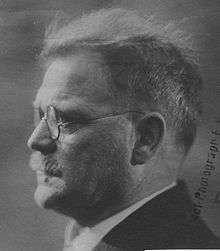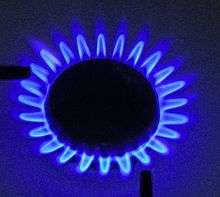Blau gas
Blau gas (German: Blaugas) was an artificial illuminating gas similar to propane, named after its inventor, Hermann Blau[1][2] of Augsburg, Germany. It was manufactured by decomposing mineral oils in retorts by heat and compressing the resulting naphtha until it liquefied. It was transported in liquid condition, and like LPG, when released it returns to gaseous state.[3] Chemically, it is similar to coal gas.[4][5]

Blau gas is not blue, but has a rather water-like color. It was stored in steel cylinders for shipment and had the advantage that it possessed the highest specific energy of all artificially produced gases, but unlike coal gas, it was free from carbon monoxide.
Blau gas was burned for lighting and heating; a less-pure form known as Pintsch gas fueled railroad car lights and stoves in the late 19th and early 20th centuries. Blau gas was most famous, however, as the buoyancy compensating fuel for the LZ 127 Graf Zeppelin.[6] It had several advantages over liquid fuels such as gasoline. Because it weighs approximately the same as air, burning it and replacing its volume with air did not lighten the airship, eliminating the need to adjust buoyancy or ballast in-flight.[7]
Blaugas contains about 50% olefins (alkenes), 37% methane and other alkanes, 6% hydrogen and the rest is air. The heat of combustion is 122 MJ/m3 [4]
See also
- August Riedinger
- History of manufactured gas
- K-1 (airship)
- Airship
References
- John Bonner; George William Curtis; Henry Mills Alden; Samuel Stillman Conant; John Foord; Montgomery Schuyler; John Kendrick Bangs; Richard Harding Davis; Carl Schurz; George Brinton McClellan Harvey; Henry Loomis Nelson; Norman Hapgood (1908). Harper's weekly. Harper's Magazine Co. Retrieved 3 May 2012.
hermann Blau blaugass.
- Chamber of Commerce journal of Maine. 1913. Retrieved 3 May 2012.
- The Modern world encyclopaedia : illustrated. Home Entertainment Library. 1935. OCLC 1091880941.
- http://chestofbooks.com/crafts/metal/Welding-Cutting/Blau-Gas.html
- Teed, P. L. (1931). "Gas Fuels for Airships: The Manufacture of Blau Gas, with Details of Some Possible Alternatives". Aircraft Engineering and Aerospace Technology. 3 (2): 41–42. doi:10.1108/eb029368.
- Graf Zeppelin site Archived 2006-08-25 at the Wayback Machine
- "Blue Gas & Hydrogen". TIME, October 15, 1928
